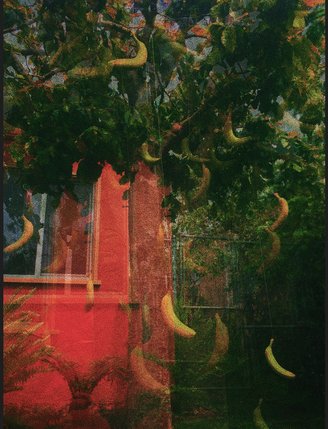
Art by student Ivy O. Images inspired by Bill Funkhouser’s “Art from Nature” lesson, made by Ken Weiderman’s seventh and eighth-grade students at Zane Middle School last spring.
###
Pacific Union teacher Zach Lehner describes his sixth grade class as
a little island — isolated from the rest of the school, out there
all alone on the internet. “It’s just me and my kids,” he said.
“So creating community, I think it’s so important.” Art, Lehner
has found, is the avenue to fostering a classroom community. It’s
what he’s always relied on, pre- and post-COVID.
“This
is very important,” Lehner told the Outpost recently. “It’s not just, ‘let’s try
to throw some paint into this lesson.’ It’s bigger than that.”
For
some newly online curriculums in Humboldt County, art has been a
casualty — a cut that Stacy Young, program manager for the arts for
the Humboldt County Office of Education, is concerned about. “If
we’re not teaching that to students, then they are not getting a
complete and whole education,” she said.
Young is talking about the many branches of developmental skills that are rooted in artistic exploration, including collaboration, reflection, curiosity, persistence and creation. Art has been limited in some schools because art lessons are hard to emulate virtually, and because they’re sometimes considered less necessary than other areas of curriculum. “Because the arts are not tested, some schools will not focus on them,” Young said.

Image by Mia L.
According
to Young and her colleague, HCOE Arts Learning Specialist Bill
Funkhouser, art in education is, in fact, very necessary, and can be
weaved into lessons across a curriculum of many subjects. Creating
art aids social emotional learning, while “reading” it promotes
wonder and engagement. Theatre bonds children together. Co-writing
stories encourages students to compromise. Taking two minutes to
observe an artwork — be it a photo of a clearcut or a painting of
Lady Liberty — invests kids in the material before the lesson has
even started. But these practices are harder to maintain virtually.
To
solve the limited opportunity to do art in school, some of Humboldt’s
educators are developing innovative ways to stimulate creation in
youth from afar.
Lehner, who is known for creating raps to accompany lessons, has plans to keep his students creating and collaborating. In place of mini performances, the class will be doing reader’s theatre over Zoom, which they’ll write themselves in small groups. They’ll also be creating one cumulative piece of artwork by circulating it through the mail until every student has contributed. “It’s hard, with Zoom,” Lehner admitted, but it’s possible.

Image by Eleia C.
The
Arcata Playhouse is home to Artists in Schools, a theatre-focused
program that normally sends professional artists to give workshops in
local elementary schools. Last semester the program adjusted for the
pandemic and started posting lessons on YouTube. Now, Artists in
Schools is working on a stream awareness project, called Keep the
Giant Jolly, which will involve virtual meetings every two weeks and
culminate in an outdoor display of large aquatic artworks.
The
goal of these efforts is to keep youth engaged with each other and
with the community. “Keeping that connection, keeping those
artistic fires burning are just really important,” said Sarah
Mckinney, Arcata Playhouse education director.
McKinney
also oversees Apprentice Entertainment, a teen group that used to
stage performances and organize events, including game nights, ice
cream socials and anti-prom before the pandemic. This semester
they’re working on producing one-person plays and monologues, which
will be filmed and shared with the community online.
Traditional
artistic events are being reimagined at HCOE, too. Young said that
she hopes to virtually preserve the All County Music Festival, which
is an annual event that invites student musicians to perform together
at Humboldt State University. “We’re buying microphones for the
area high schools so that the kids can come in one by one, socially
distanced, and play the one song perfectly,” Young said. Once every
student has been filmed, the videos will be matched together to
create a virtual ensemble. The result would be something like this.
Funkhouser
helps teachers incorporate all areas of creativity across entire
curriculums. Right now he’s working on an arts integration grant,
which serves four counties and about 100 teachers. The arts
integration project has a website
where anyone can view lessons and resources. When schools shut down
last spring, Funkhouser started developing a collection of lessons
called #CreateAtHome.
One
of the lessons is on photojournalism. “What if students took a look
at the world around them and acted like photojournalists and
chronicled this time in history?” Funkhouser said. “Instead of
being victims of it, we’re instead, you know, documenters of it.”
Other
lessons are “Art from Nature” and “Art from Anything” which
encourage kids who might have limited supplies at home to be
creative. The lessons are designed to help students reorient their
perspective and find peace during the pandemic.
“There’s this mindset about, ‘oh, art is fun, but you do it after all the real learning has happened,’” Funkhouser said. “That’s not what this is. This is a vehicle towards the real learning. This is a vehicle towards taking the learning even deeper.”
CLICK TO MANAGE